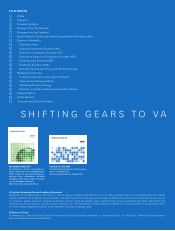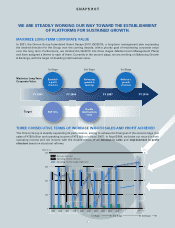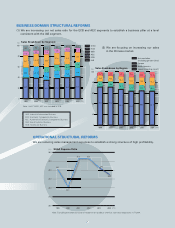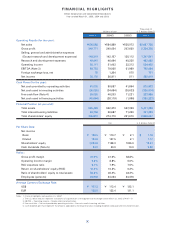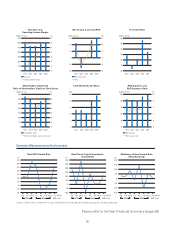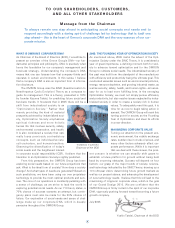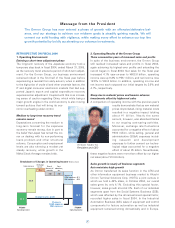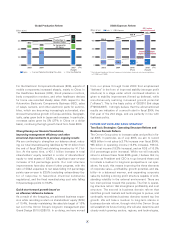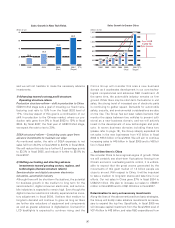Omron 2005 Annual Report Download - page 10
Download and view the complete annual report
Please find page 10 of the 2005 Omron annual report below. You can navigate through the pages in the report by either clicking on the pages listed below, or by using the keyword search tool below to find specific information within the annual report.
8
For the Electronic Components Business (ECB), exports of
mobile components increased sharply, mainly to China. In
the Healthcare Business (HCB), blood pressure monitors,
body composition monitors, and other healthcare devices
for home use recorded steady sales. With respect to the
Automotive Electronic Components Business (AEC), sales
of relays, sensors, and other electronic parts for automo-
biles, which are becoming increasingly automated, also
showed tremendous growth in Europe and Asia. Geograph-
ically, sales grew both in Japan and overseas. In particular,
overseas sales grew by 8% (27% in China on a dollar
basis), continuing the high growth trend from fiscal 2003.
Strengthening our financial foundation,
improving management efficiency and other
structural improvements to produce ongoing results
We are continuing to strengthen our balance sheet, reduc-
ing our total interest-bearing liabilities by ¥31.9 billion from
the end of fiscal 2003 and shrinking inventory by ¥1.7 bil-
lion. At the same time, a ¥31.1 billion increase in total
shareholders’ equity resulted in a ratio of shareholders’
equity to total assets of 52.2%, a significant year-on-year
increase of 5.8 percentage points. Our cost structure
improvements have also shown further progress, with the
ratio of SG&A expenses to net sales falling 0.8 percentage
points year-on-year to 23.5% (excluding extraordinary fac-
tor of response to hazardous chemical substance
regulations), and the fixed manufacturing cost ratio falling
0.8 percentage points to 16.2%.
Quick start toward growth based on
an offensive/defensive balance
As a result of the foregoing, we achieved business expan-
sion while recording a return on shareholders’ equity (ROE)
of 10.4%, thereby maintaining the absolute target of 10%
set out in the Omron Group’s long-term management plan
Grand Design 2010 (GD2010). In so doing, we have moved
from our phase through fiscal 2003 that emphasized
“defense” in the form of improved stability (stronger profit
structure) to a stage under which continued attention is
given to stability improvement (firmed up defense), while
simultaneously realizing increased growth potential
(“offense”). This is the basic policy of GD2010 2nd stage
(FY2004-2007). I strongly believe that the aforementioned
results are indicative of a smooth start in fiscal 2004, the
first year of the 2nd stage, and are perfectly in line with
that basic policy.
FUTURE OUTLOOK AND BASIC STRATEGY
Two Basic Strategies: Operating Structure Reform and
Business Domain Reform
The Omron Group aims to increase sales and profits in fis-
cal 2005. In particular, as of July 2005, we aim to record
¥625 billion in net sales (a 2.7% increase over fiscal 2004),
¥65 billion in operating income (15.8% increase), ¥36 bil-
lion in net income (19.3% increase), and an ROE of 10.8%
(0.4 percentage point increase). While we will naturally
strive to achieve these fiscal 2005 goals, I believe that my
mission as President and CEO is to go beyond these and
to include a medium to long-term perspective in our oper-
ations. As such, this means improving the three elements
of corporate value—profitability, growth potential, and sta-
bility—in a balanced manner, and expanding corporate
value by building a strong profit structure capable of with-
standing volatility in the external environment. There are
two main policies toward this purpose. The first is operat-
ing structure reform that strengthens profitability and cost
structure. The second is business domain reform that
identifies growth markets and technologies to pursue, and
continually recombines business domains toward top line
growth. We will take a medium to long-term stance in
business domain reform, through which the Omron Group
will establish its future footing. We will also determine and
closely watch growing sectors, regions, and technologies,
Japan Overseas Production (Excluding China Area) China Area Production
Global Production Reform
2004 (FY)2003 2007
(Target)
400
300
100
200
0
71%
20%
9%
67%
21%
12%
51%
19%
30%
(Billions of yen)
Production in
Greater China
to increase by
4.5 times
SG&A Expenses Reform
2004 (FY)2005
(Plan)
2003 2007
(Target)
800
600
200
400
0
(Billions of yen) Sales SG&A Expenses
24.3%
584.9 608.6
625.0
71% 22.0%
28% sales
growth planned
Increase of SG&A
expenses controlled
23.3%
23.5%
750.0
* Excluding extraordinary factor of response to hazardous chemical substance regulations
in FY2004 and FY2005
※※


